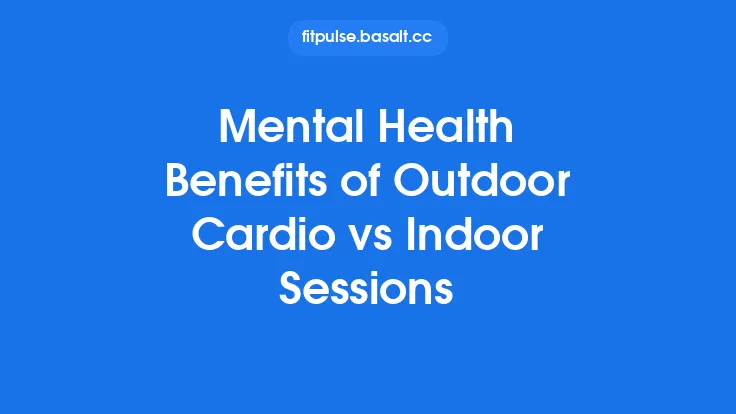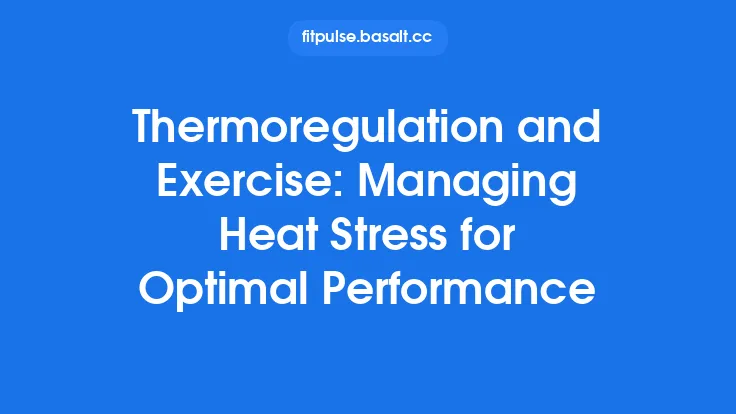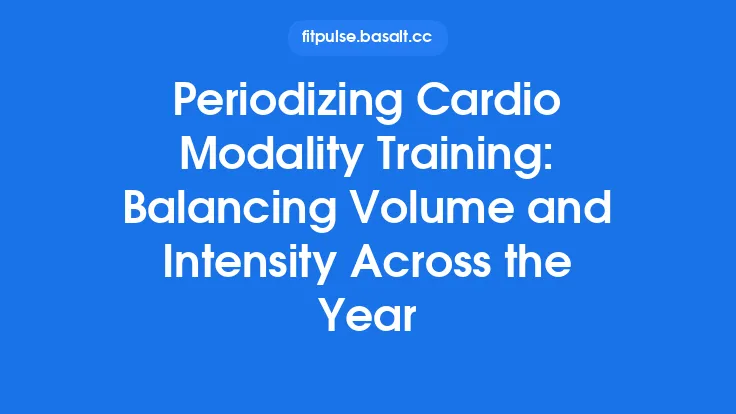Cardiovascular conditioning performed outdoors is uniquely shaped by the surrounding environment. While the body’s internal mechanisms drive the fundamental response to aerobic effort, external variables can amplify or diminish performance, affect perceived exertion, and influence training outcomes. Understanding these environmental factors allows athletes, coaches, and recreational exercisers to make informed decisions about when and how to train outside, and to interpret performance data within the proper context.
Altitude and Barometric Pressure
Physiological impact
At higher elevations, atmospheric pressure drops, reducing the partial pressure of oxygen (PO₂) in the inhaled air. This translates to a lower arterial oxygen saturation (SaO₂) for any given ventilation rate. The cardiovascular system compensates by increasing heart rate (HR) and stroke volume to maintain cardiac output (CO), while the respiratory system elevates minute ventilation (VE) to boost oxygen uptake (VO₂). The net effect is a higher relative intensity for the same absolute workload, often reflected in an elevated perceived exertion (RPE) and a quicker onset of fatigue.
Training implications
- Acute exposure: A sudden shift from sea level to moderate altitude (≈1,500–2,500 m) can cause a 5–10 % reduction in VO₂max.
- Acclimatization: Over 2–4 weeks, erythropoietin (EPO) production stimulates red blood cell mass expansion, partially restoring oxygen-carrying capacity.
- Performance monitoring: When comparing sessions across altitudes, normalizing HR zones or power output to sea‑level equivalents helps maintain consistent training loads.
Ambient Temperature and Thermal Stress
Heat stress
When ambient temperature rises above the thermoneutral zone (≈20–22 °C for most adults), the body must dissipate excess metabolic heat. Cutaneous vasodilation and sweating increase, diverting blood flow from active muscles to the skin. This redistribution can lower maximal muscle perfusion, reducing VO₂max by roughly 5–7 % for each 5 °C increase above 20 °C. Additionally, sweat loss leads to dehydration, which raises blood viscosity and further strains cardiac output.
Cold stress
Conversely, exercising in temperatures below ≈10 °C triggers peripheral vasoconstriction to preserve core temperature. Reduced skin blood flow limits heat loss but also diminishes the capacity for convective heat exchange, potentially causing a modest rise in core temperature during prolonged effort. Cold air also increases airway resistance, which can elevate the work of breathing and marginally raise HR at a given workload.
Thermoregulatory considerations
- Core temperature: The hypothalamus regulates set‑point adjustments; sustained core temperatures above 38.5 °C impair enzymatic activity and muscle contractility.
- Sweat rate: Average rates range from 0.5–2 L h⁻¹, scaling with intensity and temperature. Excessive loss (>2 % body mass) can impair aerobic performance.
Humidity and Sweat Evaporation
Evaporative cooling efficiency
Sweat evaporation is the primary mechanism for heat dissipation during vigorous activity. Relative humidity (RH) dictates the gradient for water vapor transfer from skin to air. In high‑humidity environments (RH > 70 %), the gradient narrows, slowing evaporation and forcing the body to rely more heavily on convective and radiative heat loss, which are less effective at high temperatures. This can raise core temperature and HR for a given workload.
Physiological consequences
- Reduced VO₂max: Studies show a 1–2 % decrement in VO₂max for each 10 % increase in RH when temperature is held constant.
- Increased perceived exertion: The combination of higher skin temperature and reduced evaporative cooling elevates RPE, often prompting earlier fatigue.
Wind and Aerodynamic Drag
Drag force fundamentals
When moving through air, an athlete experiences a resistive force proportional to the square of velocity (Fd = ½ ρ Cd A v²), where ρ is air density, C_d the drag coefficient, A the frontal area, and v the relative wind speed. Headwinds increase effective velocity, raising the drag force and consequently the metabolic cost of maintaining a given speed.
Quantitative impact
- A 5 km h⁻¹ headwind can increase the energy cost of running by ≈5–7 % at typical recreational speeds (≈10 km h⁻¹).
- For cyclists, the effect is more pronounced due to higher speeds and larger frontal area; a 10 km h⁻¹ headwind may raise power requirements by 15–20 % at 30 km h⁻¹.
Wind direction variability
Crosswinds alter the effective frontal area and can induce lateral instability, subtly increasing muscular effort for balance and posture control, especially in activities like trail running or mountain biking.
Solar Radiation and UV Exposure
Thermal load from solar gain
Direct solar radiation adds heat to the body’s surface, effectively raising the ambient temperature experienced by the skin. On a clear day, solar irradiance can contribute up to 800 W m⁻², increasing skin temperature by several degrees. This additional thermal load intensifies the demand for evaporative cooling, accelerating sweat loss and raising cardiovascular strain.
Physiological ripple effects
- Elevated HR: The cardiovascular system compensates for the extra heat load, often resulting in a 5–10 % increase in HR at a given workload compared with shaded conditions.
- Altered fluid balance: Higher sweat rates in sunny environments can hasten dehydration, influencing plasma volume and cardiac output.
UV considerations
While primarily a dermatological concern, UV exposure can indirectly affect performance by prompting protective behaviors (e.g., seeking shade, applying sunscreen) that may alter training patterns or perceived comfort.
Terrain and Surface Characteristics
Mechanical work and energy cost
The nature of the ground—whether paved, grass, trail, sand, or snow—modifies the mechanical work required for forward progression. Soft or uneven surfaces increase the vertical displacement of the center of mass and demand greater stabilizing muscle activity, raising the overall metabolic cost.
Surface-specific effects
- Hard surfaces (asphalt, concrete): Offer low compliance, minimizing energy loss but increasing impact forces, which can affect joint loading over time.
- Soft surfaces (sand, loose gravel): Require additional force generation to overcome surface deformation, potentially increasing VO₂ consumption by 10–20 % at the same speed.
- Uneven terrain (trail, forest floor): Engages proprioceptive and stabilizing musculature, raising HR and oxygen demand even at modest speeds.
Gradient and elevation change
Running or cycling uphill imposes a gravitational component to the workload, increasing the required power output proportionally to the slope angle (P = m g sinθ v). Conversely, downhill sections reduce metabolic demand but increase eccentric muscle loading, which can affect fatigue patterns.
Air Density and Oxygen Availability (Beyond Altitude)
Temperature and pressure interplay
Air density (ρ) is a function of temperature, pressure, and humidity. Warmer air is less dense, reducing aerodynamic drag but also slightly lowering the absolute amount of oxygen per unit volume. While the effect on VO₂max at sea level is modest (≈1–2 % per 10 °C rise), it becomes more relevant when combined with high temperature and humidity.
Practical implications
- Reduced drag: Lower density can marginally improve speed for a given power output, beneficial for cyclists and runners in hot, low‑pressure environments.
- Oxygen partial pressure: The decrease in PO₂ with reduced density can subtly elevate HR and ventilation at high intensities, even without a change in altitude.
Microclimate Variability in Different Outdoor Settings
Localized environmental pockets
Even within a single geographic region, microclimates can differ dramatically. Urban canyons, forested groves, waterfronts, and open fields each present distinct thermal, wind, and radiative profiles.
Key microclimatic factors
- Urban heat islands: Concrete and asphalt absorb and re‑radiate heat, raising ambient temperature and reducing night‑time cooling.
- Shade and canopy cover: Trees and vegetation lower ground temperature through evapotranspiration, decreasing thermal stress and solar load.
- Wind tunnels: Valleys or gaps between buildings can channel wind, amplifying aerodynamic drag or providing cooling breezes, depending on direction.
Training interpretation
When logging outdoor cardio sessions, noting the specific setting (e.g., “park trail under canopy” vs. “city sidewalk”) helps contextualize HR and pace data, allowing for more accurate longitudinal performance tracking.
Integrating Environmental Awareness into Cardio Programming
While the focus here is on the immutable aspects of the outdoor environment, the practical upshot for cardiovascular conditioning is clear:
- Baseline assessment: Establish performance metrics (HR zones, pace, power) under standardized, moderate conditions to serve as a reference point.
- Environmental logging: Record temperature, humidity, wind speed, altitude, and terrain type for each session. Modern wearables often capture many of these variables automatically.
- Data normalization: Apply correction factors—such as altitude‑adjusted VO₂max estimates or wind‑adjusted power calculations—to compare sessions across disparate conditions.
- Progressive exposure: Gradually introduce higher altitudes, hotter temperatures, or more demanding terrains to stimulate physiological adaptations without overwhelming the system.
- Recovery planning: Recognize that sessions conducted under extreme thermal or altitude stress may impose greater systemic load, warranting extended recovery or reduced subsequent training intensity.
By systematically accounting for the environmental variables that shape outdoor cardio performance, athletes can extract reliable training signals, optimize physiological adaptations, and maintain consistent progress regardless of where the pavement, trail, or path leads.





